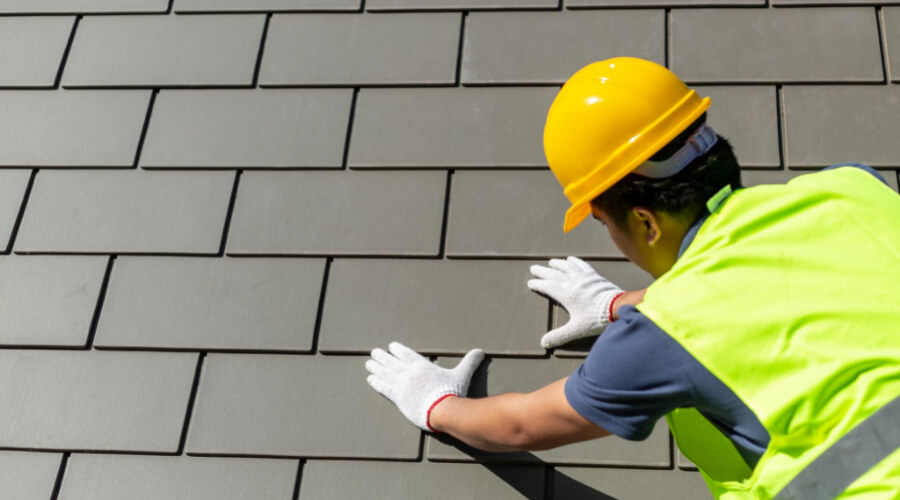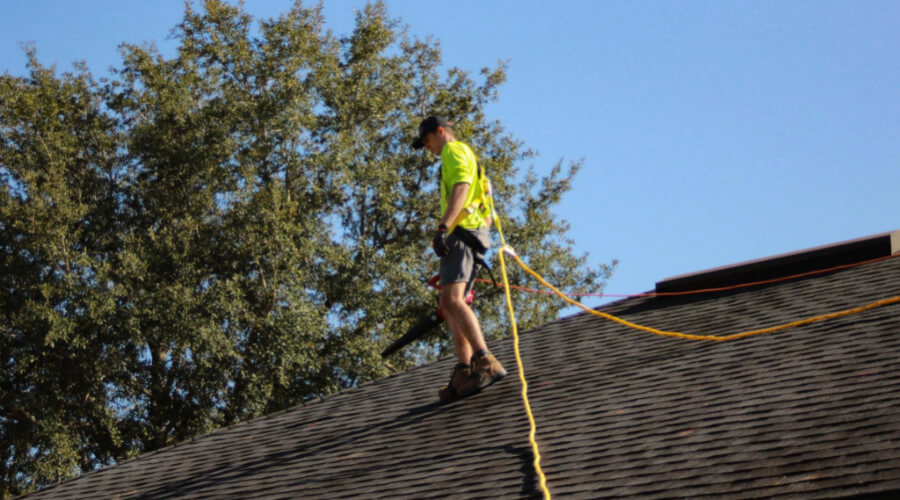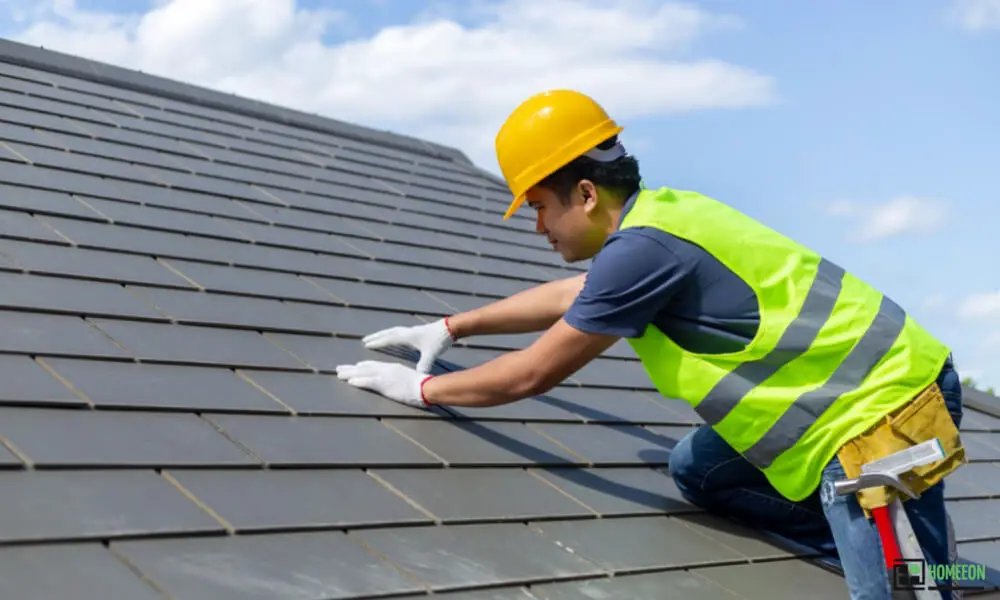Last Updated on July 16, 2023 By Emma W. Thomas
Measuring roofing squares involves calculating the total area of a roof for estimating materials needed accurately. Each roofing square represents 100 square feet. Measure the length and width of each roof section and multiply to find its area in square feet. Add up all sections’ areas, then divide by 100 to determine the total number of roofing squares. For complex roofs, break them into simpler shapes and measure them separately.
Steps Of Measuring Roofing Square Footage

The best way to get precise results is to hire a roofing contractor. However, these steps can help you get a rough estimate of roofing squares as they significantly impact the cost.
1. Prepare
Prepare yourself adequately by using a long ladder. Ensure you wear protective gear like boots with traction and a helmet. Carry a notebook to jot down the measurements you will convert to square units.
2. Measuring The Roof
Take a tape measure and get the length and width of your roof, including the dormer windows. If working with a contractor, let him take all measurements for all roofing details.
3. Calculation
Multiply the length by the width of the roof to get the square footage of your roof. Divide your product by 100 to convert the measurements to square units. For example, if your answer is 4000 square feet, divide it by 100 (4000 ÷ 100 = 40) to get 40 roofing square units.
What Is a Roofing Square?
A roofing square is a unit of measurement used in the construction industry to quantify the area of a roof. One roofing square is equal to 100 square feet (10 feet by 10 feet) of roof surface area. Roofing squares are commonly used to estimate the amount of roofing materials needed for a project, such as shingles or roofing tiles.
When calculating roofing estimates, contractors and suppliers often refer to the number of squares required, making it easier to determine the overall cost and materials required for a roofing job. This standardized measurement simplifies the process of planning and executing roofing projects.
Who Does Not Use Roofing Squares?
In most construction works, the term is often confusing with square meters and square feet. However, roofing squares are typical for roofers, while plumbers and those who install tiles don’t use roofing squares. Most of them use square meters, which is different from roofing squares.
Measuring Roofing Squares Without Getting On The Roof
There are many ways to get the roofing squares, but you can get exact measurements using mathematical principles. Use the Pythagoras theorem to get the measurements. If your house has two slanting sides, this method gives the correct values, except for chimneys and other protrusions in the roof. Get the distance halfway from the slanting point to the end of the overhang and note it down. Using the tape measure, get the height of elevation from the base of the roof, and this will help you get the angle of elevation.
You can get the slanting height by finding the sum of the base and height independently after getting their squares. Finally, get the square root of the value of the slanting height to get the measurements you require. Although this method is mathematical, it saves time, and you can do it yourself. This makes it easy to get the roofing squares without getting on the roof. However, you can have a roofer do it for you if you are unsure.
The Standard Unit For Roofing Square Measurements

Roofing squares as units of measurement have an international system of units vital during various circumstances. Since the measurements are in square feet, they are constantly used when shipping roofing materials to different regions. This helps maintain a constant unit of measure without distorting the anticipated measurements by the customers of other companies.
Using Dimensions Of A Roofing Square
The roofing square is a total of 100 square feet. You can get a rough estimate by walking and measuring the sizes of your strides in feet. Usually, an adult has strides of 2 to 2.5 feet. Walk around the length of the roof and repeat for the width. Multiply the length dimensions by width to get the number of your roof’s square units. Note that this is to give a rough estimate and may not include the sophisticated parts of the roof. Always add 15% to your results to cater to labor and additional costs.
How To Measure Roofing Squares Online
Sometimes it is easy to treat a roofing square measuring process as a DIY process. You can do it online by using Google Earth to get the measurements faster and more accurately. You have to key in the location of your house and have a bird’s eye view of your roof.
From this point, Google will give you the dimensions of your roof, and you can use another roofing calculator to convert the measurements into square feet. With a few clicks, you can get the number of shingles for the roof, and even the cost because working online is more manageable.
What Is The Average Roofing Square Of A House?
There is no specific measurement for a standard house since the size of the roof depends on the homeowner’s decision. Nonetheless, most roofing square measurements in the United States have an average of 1700 square feet. Some houses have larger roofs, while others are small.
Why Should You Know How To Measure Roofing Squares?
You should know to measure roofing squares to determine the price and cost of roofing materials. In fact, most of the roofs are not perfect squares. Getting the roofing square will help you know the exact measurements and avoid assumptions. Roofing squares also help determine the number of squares to help you plan for the price of the roof, including the installation requirements.
Measuring roofing squares give you the approximate time for roofing. This data is essential to help you select the appropriate roofers who charge hourly rates. It also becomes easy at an early stage of financial planning when you know how much time you require to complete the project. Therefore, learning how to measure roofing squares is essential.
Which Is The Best Tool For Measuring Roofing Squares?
Roofing squares are linear forms of measurement that help you get the roof’s square footage. Therefore, different rulers, such as measuring tape, help you measure the roofing squares. Most of them allow you to measure various dimensions like angles and positioning of rafters when fixing the roof.
Roofing Squares For A Bundle Of Shingles
There is no need to measure the roofing squares for a bundle of shingles because of their existing standard measurements. Standard shingles measure 12 x 36 inches in a package of 29. A single shingle has three bundles that provide 33.33 square feet. Alternatively, it represents 0.33 squares on the surface of the roof. The necessary measurement is the total square footage and dividing it by 0.33 to get the basic package of shingles for the roof.
What To Consider When Measuring Roofing Squares
Once more, many houses do not have square roofs, indicating possible errors for assumptions. The complexity and stiffness affect the computation of your data. For example, you have to multiply your square foot units by 1.3 to get the square footage of a gabble roof. Multiply the data by 1.4 for accuracy and precise values for a roof with a slight slope.
Steep and complex roofs are technical and may not always fit the shingles. In such circumstances, the best way is to multiply the roofing square measurements by 1.6 to obtain square footage. In other words, the roof slope determines how to calculate the roofing squares after taking the measurements. The methods are not 100% accurate. Use a roofing square calculator to find the number of shingles for your roof.
Hiring Experts VS. DIY In Measuring Roofing Squares
Measuring roofing squares is pretty easy when doing it yourself because of reduced costs. Having the tools is not a guarantee of getting the correct measurements. Some roofs are complex and may require skilled personnel. That is why hiring an expert is the best choice, as it doesn’t compromise the integrity of your roof. An expert is versed in measuring tools and will advise on the cost to save you time from consulting roofing companies.
Is It Difficult To Measure Roofing Squares?
Measuring roofing squares is a straightforward procedure that anyone does with the know-how. Generally, it is easy to measure roofing squares since the entire process takes less time. The basic requirements are the necessary tools to get started. However, the process may be hectic if you are unfamiliar with using the tools. Some roofs with irregular shapes may be challenging if new to the field.
Are Overhangs Included When Measuring Roofing Squares?
All roof parts are counted in the measurements to determine the total footage. These include dormers, sections of chimneys, and other protrusions on the roof, except for gutters. Include overhangs in measuring roofing squares for convenience during installation or replacement.
The overhangs can be starting points for measuring roofing squares from one end to another. If the house has a complex shape, divide your measurements into overhang sections. Another option is to measure the roofing squares for the entire home and add the overhangs as final values.
Final Thought
Measuring roofing squares is easy when you have an expert around. You do not have to get on the roof to take the measurements, but professional help is always necessary. Consider the complexity and stiffness of your roof to determine the cost of materials for your project. Utilize online roofing squares measuring sources by comparing the results from the contractor and online sources to get approximate figures.
References:
https://www.gaf.com/en-us/blog/how-to-measure-a-roofing-square-281474980068196
https://rennisonroofing.com/how-big-is-a-roofing-square/
Emma is a graduate of Domestic Science or Family and Consumer Sciences (Home Economics) from the University of Wisconsin. She has 7 years of experience Working with the strategic section of BestBuy and now writing full-time for Homeeon.
From Managing the Home, Interiors, Cleaning, and Exteriors to Gardening and everything about Making A Home Liveable – is her passion and this Homeeon is the result of this.
Emma loves decorating her home with the best stuff found online. She cares about quality over anything and writes reviews about them here in Homeeon. Get in touch with her over Pinterest.
Keep reading her blogs.

